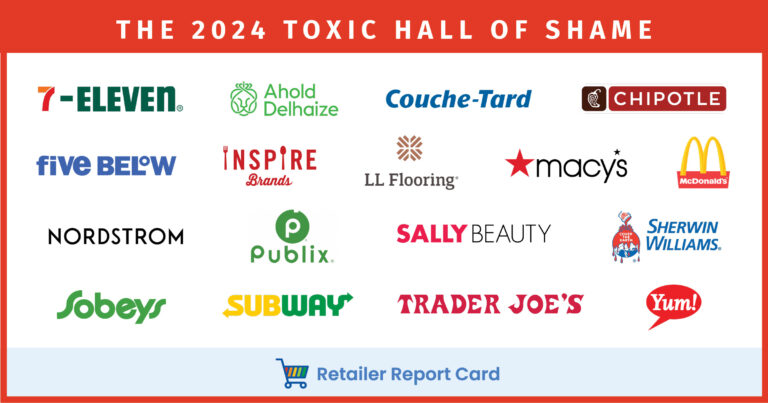Bisphenols
What are bisphenols?
Bisphenols are widely-used chemicals found in everything from food and beverage can linings to thermal paper and used to make polycarbonate plastic as well as epoxy resins. While bisphenol A (BPA) is the most well-known member of this chemical class, similar compounds such as bisphenol S (BPS) and bisphenol F (BPF) are chemical cousins that are also of concern. Unfortunately, when states and companies restricted the use of BPA, many manufacturers turned to these similar and also toxic compounds.
In animal studies, researchers have linked developmental exposure to bisphenols to reproductive and developmental harm.
How am I exposed?
Bisphenols are widely used and exposure can come directly from a number of products.1-3
- Food and drink can linings: bisphenols leach into food, drinks, and formula when they are used to line food and drink cans.
- Thermal paper: bisphenols are applied as a coating to thermal paper, commonly used for receipts as well as tickets and medical records.
- Dental materials: bisphenols can leach from dental sealants and polymers.
- Polycarbonate plastic: bisphenols are the building blocks for polycarbonate, the plastic used for compact disks and many hard, clear plastic items such as eyewear and toys.
With their widespread presence in products in our homes, schools, and workplaces, bisphenols are also found in indoor dust, an important route of toxic exposures.4 Several bisphenols have been widely detected in U.S. supermarket food, with the highest dietary exposures estimated for toddlers and infants.5
Why should I be concerned?
Bisphenols are high-production volume chemicals and are found widely in the indoor and outdoor environments and in people. With its well-established toxicity and widespread human exposure, BPA has raised the greatest amount of concern. Recent research, however, has found that other bisphenols are present at similar concentrations in the environment and have similar toxicity. At least one bisphenol, the fluorinated compound known as BPAF, is extremely persistent.6 Washington State has designated BPA, BPF, and BPS as Chemicals of High Concern for Children.7
More than 90 percent of people in the United States have been found to carry BPA residues in their bodies, and other bisphenols have also been widely detected in people.8, 9 The human body breaks down and excretes bisphenols within a few days, so these consistent measurements in humans mean that we have ongoing exposure to these compounds. BPA also has been measured in breast milk, amniotic fluid, and follicular fluid, providing evidence that the developing fetus and infant also are exposed.10
Bisphenols have been linked to harmful effects on health:
- BPA is a known hormone disruptor, and laboratory studies show that other bisphenols are also estrogenic and some are even more potent.6
- BPA and other bisphenols impact reproduction, with laboratory studies showing altered mating and maternal behavior, effects on prostate, and reproductive success.6, 11
- Laboratory studies show that bisphenols affect brain development in the areas of learning, memory, and behavior, and BPA exposure is associated with hyperactivity.11-13
- Studies in laboratory animals have found that BPA depresses the immune system.11
How can I reduce my exposure?
- When possible, choose alternatives to paper receipts such as email receipts. Otherwise, limit handling and wash hands after handling.
- Choose alternatives to polycarbonate plastic for baby bottles and sports water bottles. For babies, glass and cloudy plastic bottles are better choices. For sports bottles, the best choice is stainless steel.
- Choose powdered rather than liquid infant formula. If you do need liquid formula, use bisphenol-free containers.
- Limit your intake of canned foods.
What’s the solution?
It is impossible for us to shop our way out of this problem. And we shouldn’t have to. When you walk into a store, you should be able to trust that the products on store shelves are safe.
Companies shouldn’t sell products with dangerous chemicals—especially as scientists continue to learn more about the “silent epidemic” caused by the cumulative impact of all the toxic chemicals we are regularly exposed to. And our state and federal governments shouldn’t allow chemicals on the market until they’re proven safe.
The only way to protect everyone from toxic chemicals like bisphenols is to change policies at government and corporate levels to make sure that safer solutions are the norm.
We’re fighting every day to protect you and your loved ones from toxic chemicals like this. To join our fight, please consider making a donation, taking action with us, or signing up for our email list.
Healthy Choices
Our Key Projects
Take Action

Endnotes
- Hoekstra, E. J.; Simoneau, C., Release of Bisphenol A from Polycarbonate—A Review. Critical Reviews in Food Science and Nutrition 2013, 53, (4), 386-402.
- National Toxicology Program NTP-CERHR Monograph on the Potential Human Reproductive and Developmental Effects of Bisphenol A. https://ntp.niehs.nih.gov/ntp/ohat/bisphenol/bisphenol.pdf
- Washington Department of Ecology Priority Consumer Products Report to the Legislature: Safer Products for Wahsington Implementation Phase 2. https://apps.ecology.wa.gov/publications/documents/2004019.pdf
- Mitro, S.; Dodson, R.; Singla, V.; Adamkiewicz, G.; Elmi, A.; Tilly, M.; Zota, A., Consumer product chemicals in indoor dust: a quantitative meta-analysis of U.S. studies. Environ Sci Technol 2016, 50, (10661-10672).
- Liao, C.; Kannan, K., Concentrations and Profiles of Bisphenol A and Other Bisphenol Analogues in Foodstuffs from the United States and Their Implications for Human Exposure. Journal of Agricultural and Food Chemistry 2013, 61, (19), 4655-4662.
- Chen, D.; Kannan, K.; Tan, H.; Zheng, Z.; Feng, Y.-L.; Wu, Y.; Widelka, M., Bisphenol Analogues Other Than BPA: Environmental Occurrence, Human Exposure, and Toxicity—A Review. Environmental Science & Technology 2016, 50, (11), 5438-5453.
- Washington Department of Ecology Chemicals of high concern to children. https://ecology.wa.gov/Regulations-Permits/Reporting-requirements/Childrens-Safe-Products-Act-Reporting/Chemicals-of-high-concern-to-children
- Calafat, A., X Ye, L-Y Wong, JA Reidy, and LL Needham, Exposure of the U.S. population to bisphenol A and 4-tertiary-Octylphenol: 2003-2004. Environmental Health Perspectives 2008, 116, (1), 39-44.
- Liao, C.; Liu, F.; Alomirah, H.; Loi, V. D.; Mohd, M. A.; Moon, H.-B.; Nakata, H.; Kannan, K., Bisphenol S in Urine from the United States and Seven Asian Countries: Occurrence and Human Exposures. Environmental Science & Technology 2012, 46, (12), 6860-6866.
- Vandenberg, L., R Hauser, M Marcus, N Olea, and WV Welshons, Human exposure to bisphenol A (BPA). Reproductive Toxicology 2007, 24, (2), 139-177.
- Office of Environmental and Health Hazard Assessment Toxicological Profile for Bisphenol A. http://www.opc.ca.gov/webmaster/ftp/project_pages/MarineDebris_OEHHA_ToxProfiles/Bisphenol%20A%20Final.pdf
- Richter, C., LS Birnbaum, F Farabollini, RR Newbold, BS Rubin, CE Talsness, JG Vandenbergh, DR Walser-Kuntz, FS vom Saal, In vivo effects of bisphenol A in laboratory rodent studies. Reproductive Toxicology 2007, 24, (2), 199-244.
- Rochester, J. R.; Bolden, A. L.; Kwiatkowski, C. F., Prenatal exposure to bisphenol A and hyperactivity in children: a systematic review and meta-analysis. Environment International 2018, 114, 343-356.




